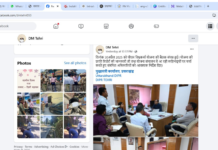A. INTRODUCTION
i.
Information Technology (IT) is key driver of an increasingly knowledge based global economy. Given its current global position in the IT sector, India is well
positioned to enhance and leverage its capabilities towards this end. Industrialized and developing countries alike are formulating policies and programs to accelerate
IT to reap the benefits of development and dissemination.
ii. It is regarded as a “key” technology developing speedily. It is regarded as generic, strategic and
critical core area. All developing and developed countries have since recognized the importance of IT and use a variety of policies and joint public-private programs
to increase IT proliferation. In developing countries also, it has been established that IT has the potential to enhance competitiveness of key industries, modernize
basic infrastructure and services, alleviate information poverty and reduce transaction costs throughout the economy. These countries use IT in key areas like macro-
economic planning and decision making, public administration, education, health-care, manufacturing, finance and banking, transportation, commerce, publishing, energy
conservation and environmental management.
iii. Major IT hubs in India like Bangalore, Chennai, Hyderabad, Mumbai, Pune and NCR which account for nearly 90% of the
total ICT Industry in India are nearly saturated and face infrastructural challenges and human resource constraints for further expansion. This necessitates the
absolute imperative for Indian. ICT&E Industry to diversify into Tier II and Tier III cities of Uttarakhand. In line with the Global trends, it is imperative that
State of Uttarakhand initiates timely and prompt measures with the aim delivering the benefits of ITC&E revolution to its residents.
iv. The National Policy on IT focuses on application of technology-enabled approaches to overcome monumental developmental challenges in education, health, skill
development, financial inclusion, employment generation, governance etc. to greatly enhance efficiency across the board in the economy. The Uttarakhand State policy
seeks to achieve the twin goals of bringing the full power of IT within the reach of the state and harnessing the capability and human resources of the state to enable
Uttarakhand to emerge as the Global/National Hub and destination for IT, ITES by 2025.
v. The focus of the IT policy is therefore on deployment of ICT in all sectors of the economy, on providing IT solutions in the State. This Policy aims at attaining
these objectives through coordinated action on the part of various key stakeholders within the State.
vi. In addition to ICT proliferation, there is a need to set up and enhance the electronics manufacturing units within the State under the umbrella of “Make in India”
initiative of the Gol. This would reduce the cost of various components that are currently being procured ex-import. Electronics Hardware Industry consists of
electronic systems design and manufacturing, which comprises of semiconductor design, high-tech manufacturing, electronic components and electronic system design for
consumer electronic products, telecom products & equipment, IT systems and hardware. Electronics industry reported at USD 1.75 Trillion is the largest and fastest
growing manufacturing industry in the world. Currently the demand for electronics hardware is projected to increase from USD 45 billion in 2009 to USD 400 billion by
2020. (as per Meity, Gol)
vii. Stake Holders: The key Stake holders in the State are not only IT Dept. but also includes all Departments of the State including Police Department, Industry
representatives from different associations, all Institutes/Universities under Higher Education and Technical Education Department and citizens of the State.
B. National Objectives
i. It is imperative that the State IT Policy is aligned with the National Policies on the subject. In view of this, the key objectives of the
National Policies on “Information Technology 2012 (NPIT 2012)”, “National Policy on ESDM 2012”, “National Policy on Electronics 2012 (NPE-2012)” and “National Telecom
Policy 2012 (NTP-2012)” are included in this document and summarized below:
(a) To increase revenues of IT and ITES Industry from 100 Billion USD at present to 300 Billion USD by 2020 and expand exports from 69 Billion USD at present to 200
Billion USD by 2020.
(b) To gain significant global market-share in emerging technologies and Services.
(c) To promote innovation and R&D in cutting edge technologies.
(
d) To encourage adoption of ICTS in key economic and strategic sectors to improve their competitiveness and productivity.
(e) To provide fiscal benefits to SMEs and Startups for adoption of IT in value creation
(f) To create a pool of 10 million additional skilled manpower in IT.
(g) To make at least one individual in every household e-literate. The State of Uttarakhand would endeavor to make all residents e-literate by 2025.
(h) To provide for mandatory delivery of and affordable access to all public services in electronic mode.
(i) To enhance transparency, accountability, efficiency, reliability and decentralizat Government and in particular, in delivery of public services.
(j) To leverage in for key Social Sector Initiatives like Education, Health, Rural Develo and Financial Services to promote equity and quality.
(k) To make India global hub for development of language technologies, to encourag facilitate development of content accessible in all Indian languages and thereb
bridge the digital divide.
(1) To enable access of content and ICT applications by differently-abled people to inclusive development.
(m) To leverage ICT for expanding the workforce and enabling life-long learning.
(n) To strengthen the Regulatory and Security Framework for ensuring a Secure and compliant Cyberspace ecosystem.
(o) To adopt Open standards and promote open source and open technologies.
(p) To create an eco-system for a globally competitive ESDM sector in the country to ach turnover of about USD 400 billion by 2020 involving investment of about USD
100 and employment to around 28 million people at various levels.
(q) To build on the emerging chip design and embedded software industry to achieve leadership in Very Large Scale Integration (VLSI), chip design and other frontier
ted areas and to achieve a turnover of USD 55 billion by 2020.
(r) To build a strong supply chain of raw materials, parts and electronic components to
the indigenous availability of these inputs from the present 20-25 per cent to
over 6
2020
(s) To increase the export in ESDM sector from USD 5.5 billion to USD 80 billion by 2020.
(t) To significantly enhance the availability of skilled manpower in the ESDM sector. S
focus on augmenting postgraduate education and to produce about 2,500 PhDs annu
2020
A. Vision
“To use IT as a vehicle for economic development of State of Uttarakhand with all round inclusive growth to create a vibrant society with high quality of
life.”
B. Goals
i. Make the State of Uttarakhand fully digitized and networked society where information flow and access across all sections of the society would be enabled through
effective IT infrastructure that would propel the economic growth of the State.
ii. Employment Generation- Given the fairly high literacy rate of 79.63% (Highest among Northern States), the Government aims to reduce unemployment by encouraging IT,
ITES to establish their enterprises in Uttarakhand.
iii. To make electronics as growth engine for the state and to establish Uttarakhand as the most preferred destination for investment in the Electronics System Design
and Manufacturing (ESDM) industry.
C. Mission
The mission of this Policy is to:
1. To position State of Uttarakhand as an attractive IT investment destination in India.
ii. To leverage IT as an engine of growth for Uttarakhand.
iii. To transform physical communities into connected communities that can help to realize sustainable
economic growth and enhance the quality of life.
C. Mission
The mission of this Policy is to:
1. To position State of Uttarakhand as an attractive IT investment destination in India.
ii. To leverage IT as an engine of growth for Uttarakhand.
iii. To transform physical communities into connected communities that can help to realize sustainable economic growth and enhance the quality of life.
D. Objectives
i. Promoting Uttarakhand as an attractive investment destination for IT companies by providing congenial, industry friendly and proactive working environment.
ii. Promote prominent cities/towns in the State as emerging IT destinations by providing assistance in setting up state of the art infrastructure in the state. This
would be achieved by providing Single Window Assistance within the State.
iii. To create world class IT infrastructure as a platform to provide seamless connectivity for businesses and users, easy to use public and private services in a
vibrant ecosystem consisting of ICT operators, Service Providers, Government, Regulators and end users. The State Govt. plans to setup Electronic Manufacturing
Clusters (EMCs) under PPP Model.
iv. To upgrade and develop manpower skills required for the IT industry and to accelerate the use of IT in schools, colleges and other educational institutions with a
view to providing skills and knowledge to the youth Page 7 / 57m fit or employment in this industry. The State Govt. plans to encourage academic Institutions, ITIS
Polytechnic Institutes, private players in imparting Low and High-level Skills to students and un-skilled/semi.skilled personnel of the in the state.
vi. To upgrade the quality of life of citizens of the State by facilitating easy access to consumer applications of ICT.
vii. To use IT as GDP driver by promoting IT
industry in the State, developing the State as an attractive ICT&E destination with a view to generating employment for youth in this sector thereby raising their
earning capacity and simultaneously realizing the export as well as domestic revenue potential in this sector.
viii. To promote indigenous manufacturing of electronics
products by creating a favorable investor friendly atmosphere in the entire value chain of ESDM.
ix. To promote the development of a vibrant eco-system of R&D, design
and engineering and innovation in IT in the state with the state Government to be playing a proactively important role in this.
x. Target direct and indirect employment
generation for state residents within the state.
xi. Ensure utilization of financial assistance under ‘Scheme for Financial Assistance to select States/UTs for Skill
Development in Electronics System Design and Manufacturing (ESDM) sector as approved by Meity, Gol. The number of personnel to be trained thereafter would depend on
the enhancement/extension of this policy at the National level
v. Encourage the use of IT in the Government not only as a tool for management and decision
support systems but also to re-engineer the processes of the government to
provide a more
efficient, transparent, accountable and responsive government to its citizens. The Govt. of
Uttarakhand would take a lead in implementing IT in all its
functioning.
vi. To upgrade the quality of life of citizens of the State by facilitating easy access to consumer applications of ICT.
vii. To use IT as GDP driver by promoting IT industry in the State, developing the State as an attractive ICT&E destination with a view to generating employment for
youth in this sector thereby raising their earning capacity and simultaneously realizing the export as well as domestic revenue potential in this sector.
viii. To promote indigenous manufacturing of electronics products by creating a favorable investor friendly atmosphere in the entire value chain of ESDM.
ix. To promote the development of a vibrant eco-system of R&D, design and engineering and innovation in IT in the state with the state Government to be playing a
proactively important role in this.
x. Target direct and indirect employment generation for state residents within the state. and more….
Source Uttarakhand industry department.










